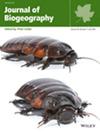Spatial Discontinuity of Mountain Systems and Genetic Structure of Alpine Plants: The Alps–Carpathians Disjunction in a Comparative Phylogeographical Context
Abstract
Aim
In mountain areas, geographical isolation and the history of mountain systems are believed to be among the most important factors that determine population distribution and connectivity. In this study, we address the importance of discontinuity among mountain systems for intraspecific genetic structure by investigating whether the geographical disjunction between the Alps and the Carpathians (and the related habitat gap) is the primary factor that shapes the genetic structure of the high-mountain plant populations. We compare the large-scale genetic structure of alpine plants from these two parts of the European Alpine System concerning the location of the main genetic split in the studied species, large-scale patterns of phylogeographical lineages and potential factors influencing their distribution.
Location
The Alps and the Carpathians.
Taxon
22 alpine/subalpine vascular plant species.
Methods
We performed Bayesian population structure analysis on genome-wide genotyping (AFLP) data and reconstructed relationships between individuals and populations using the PCoA and Neighbour Joining. We also performed AMOVA to estimate the contribution of genetic variation among regions. Based on these analyses, we examined the locations of primary and lower-level phylogeographical breaks.
Results
A clear primary genetic split between the Alps and the Carpathians was observed in three species (14% of studied species). In 17 species (77%) we identified other genetic patterns or, in some cases, we did not observe any geographical pattern (two species, 9%). We found no specific pattern of biological traits that are correlated with the genetic split between the Alps and the Carpathians.
Conclusions
The geographical gap between the Alps and the Carpathians is not a primary factor in shaping the genetic structure of the regional high-mountain flora as it aligns with a first-rank phylogeographic break in a minority of species. The genetic division between the Alps and the Carpathians appears mostly at higher K values, showing that the internal complexity of these large mountain systems plays a no less important role. Several patterns of large-scale distribution of intraspecific lineages were detected, including connections between the Carpathians and the nearest Eastern Alps, and also historical links of the Carpathians with Southern and Western Alps through latitudinally extended genetic groups.

 求助内容:
求助内容: 应助结果提醒方式:
应助结果提醒方式:


